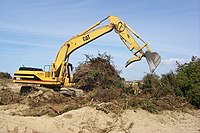Hydraulic cylinder

Hey there, kiddo! Do you know what a hydraulic cylinder is? It's like a magic stick that can push and pull things with the help of water!
First, let's talk about water. It's a liquid that can flow and fill up spaces. When we put water in a container and close it, the water will push out against the sides of the container evenly. That's called pressure.
Now imagine a big straw that can hold water and is closed on one end. If we push on the other end of the straw, the water inside will start to move and push against the closed end of the straw. This is how a hydraulic cylinder works!
Inside a hydraulic cylinder, there's a tube that holds water. There are two ends to the tube, and one end is closed. On the other end, there's a piston (a piece of metal) that fits snugly inside the tube.
When we add water to the tube, it fills up and pushes against the piston. If we push on the piston (or pull it), the water inside will move and push against the closed end of the tube. This creates pressure, and the piston will move forward or backward, depending on which way we push it.
Now think about a big machine like a bulldozer or crane. They're too heavy for us to move with our hands, right? That's where hydraulic cylinders come in. By controlling the water pressure inside the cylinder, the machine can move heavy objects, lift things up, or push things around.
So that's it, kiddo! Hydraulic cylinders use water pressure to make machines move and do cool things. Pretty neat, huh?
First, let's talk about water. It's a liquid that can flow and fill up spaces. When we put water in a container and close it, the water will push out against the sides of the container evenly. That's called pressure.
Now imagine a big straw that can hold water and is closed on one end. If we push on the other end of the straw, the water inside will start to move and push against the closed end of the straw. This is how a hydraulic cylinder works!
Inside a hydraulic cylinder, there's a tube that holds water. There are two ends to the tube, and one end is closed. On the other end, there's a piston (a piece of metal) that fits snugly inside the tube.
When we add water to the tube, it fills up and pushes against the piston. If we push on the piston (or pull it), the water inside will move and push against the closed end of the tube. This creates pressure, and the piston will move forward or backward, depending on which way we push it.
Now think about a big machine like a bulldozer or crane. They're too heavy for us to move with our hands, right? That's where hydraulic cylinders come in. By controlling the water pressure inside the cylinder, the machine can move heavy objects, lift things up, or push things around.
So that's it, kiddo! Hydraulic cylinders use water pressure to make machines move and do cool things. Pretty neat, huh?
